 W
WAn animal pound is a place where stray livestock were impounded. Animals were kept in a dedicated enclosure, until claimed by their owners, or sold to cover the costs of impounding.
 W
WThe ard, ard plough, or scratch plough is a simple light plough without a mouldboard. It is symmetrical on either side of its line of draft and is fitted with a symmetrical share that traces a shallow furrow but does not invert the soil. It began to be replaced in China by the heavy carruca turnplough in the 1st century, and in most of Europe from the 7th century.
 W
WBackpacking with animals is the use of pack animals, such as a horse, llama, goat, dog, or donkey to help carry the weight of a backpackers gear during an excursion. These animals need special considerations when accompanying backpackers on a trip. Some areas restrict the use of horses and other pack animals. For example, Great Basin National Park does not allow domestic animals at all in backcountry areas.
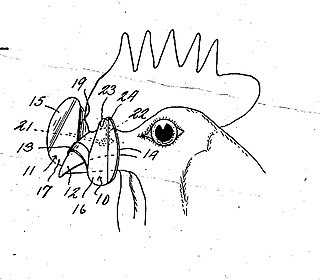 W
WBlinders, also known as peepers, are devices fitted to, or through, the beaks of poultry to block their forward vision and assist in the control of feather pecking, cannibalism and sometimes egg-eating. A patent for the devices was filed as early as 1935. They are used primarily for game birds, pheasant and quail, but also for turkeys and laying hens. Blinders are opaque and prevent forward vision, unlike similar devices called spectacles which have transparent lenses. Blinders work by reducing the accuracy of pecking at the feathers or body of another bird, rather than spectacles which have coloured lenses and allow the bird to see forwards but alter the perceived colour, particularly of blood. Blinders are held in position with a circlip arrangement or lugs into the nares of the bird, or a pin which pierces through the nasal septum. They can be made of metal (aluminium), neoprene or plastic, and are often brightly coloured making it easy to identify birds which have lost the device. Some versions have a hole in the centre of each of the blinders, thereby allowing restricted forward vision.
 W
WA cattle chute or cattle race also called a run or alley, is a narrow corridor built for cattle and other animals to travel through when being herded from one location to another that is nearby. A conventional race consists of parallel panels or fences with a space between them just wide enough for one animal to pass through comfortably without being able to turn around, thus forming the animals into a queue that only allows them to go forward. It is used for routine husbandry activities such as drafting (sorting) or loading animals via ramp or loading chute into a vehicle; placing them one at a time in a cattle crush (variations also called a squeeze chute or standing stock) for examination, marking or veterinary treatment. They are also used at packing plants to move animals into a crush designed for slaughter.
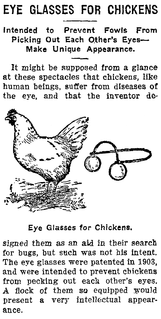 W
WChicken eyeglasses, also known as chickens specs, chicken goggles, generically as pick guards and under other names, were small eyeglasses made for chickens intended to prevent feather pecking and cannibalism. They differ from blinders as they allowed the bird to see forward whereas blinders do not. One variety used rose-colored lenses as the coloring was thought to prevent a chicken wearing them from recognizing blood on other chickens which may increase the tendency for abnormal injurious behavior. They were mass-produced and sold throughout the United States as early as the beginning of the 20th century.
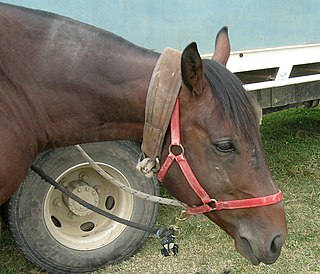 W
WAn animal collar is a device that attaches to the neck of an animal to allow it to be harnessed or restrained.
 W
WAn ear tag is a plastic or metal object used for identification of domestic livestock and other animals. If the ear tag uses Radio Frequency Identification Device (RFID) technology it is referred to as an electronic ear tag. Electronic ear tags conform to international standards ISO 11784 and ISO 11785 working at 134.2 kHz, as well as ISO/IEC 18000-6C operating in the UHF spectrum. There are other non-standard systems such as Destron working at 125 kHz. Although there are many shapes of ear tags, the main types in current use are as follows:Flag-shaped ear tag: two discs joined through the ear, one or both bearing a wide, flat plastic surface on which identification details are written or printed in large, easily legible script. Button-shaped ear tag: two discs joined through the ear. Plastic clip ear tag: a moulded plastic strip, folded over the edge of the ear and joined through it. Metal ear tag: an aluminium, steel or brass rectangle with sharp points, clipped over the edge of the ear, with the identification stamped into it. Electronic Identification Tags, include the EID number and sometimes a management number on the button that appears on the back of the ear. These can at times be combined as a matched set, which includes Visual tags with Electronic Identification Tags.
 W
WAn earmark is a cut or mark in the ear of livestock animals such as cattle, deer, pigs, goats, camels or sheep, made to show ownership, year of birth or sex.
 W
WElastration is a bloodless method of male castration and docking commonly used for livestock. Elastration is simply banding the body part until it drops off. This method is favored for its simplicity, low cost, and minimal training requirements.
 W
WA hobble, or spancel, is a device which prevents or limits the locomotion of an animal, by tethering one or more legs. Although hobbles are most commonly used on horses, they are also sometimes used on other animals. On dogs, they are used especially during force-fetch training to limit the movement of a dog's front paws when training it to stay still. They are made from leather, rope, or synthetic materials such as nylon or neoprene. There are various designs for breeding, casting, and mounting horses.
 W
WA howdah, or houdah, derived from the Arabic هودج (hawdaj), which means "bed carried by a camel", also known as hathi howdah, is a carriage which is positioned on the back of an elephant, or occasionally some other animal such as a camel, used most often in the past to carry wealthy people during progresses or processions, hunting or in warfare. It was also a symbol of wealth for the owner and as a result might be elaborately decorated, even with expensive gemstones.
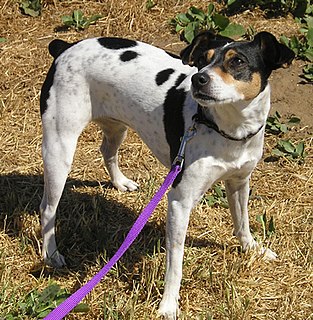 W
WA leash is a rope or similar material used to control an animal by attaching it to a collar, harness, or halter. In British English, a leash is generally for a larger animal, with lead being more commonly used when walking a dog.
 W
WA cattle crush, squeeze chute, cattle chute, standing stock, or simply stock is a strongly built stall or cage for holding cattle, horses, or other livestock safely while they are examined, marked, or given veterinary treatment. Cows may be made to suckle calves in a crush. For the safety of the animal and the people attending it, a close-fitting crush may be used to ensure the animal stands "stock still". The overall purpose of a crush is to hold an animal still to minimise the risk of injury to both the animal and the operator while work on the animal is performed.
 W
WA muzzle is a device that is placed over the snout of an animal to keep them from biting or otherwise opening their mouth.
 W
WA nose ring is inserted into the nose of an animal. Nose rings are used to control bulls and occasionally cows, and to help wean young cattle by preventing suckling. Nose rings are used on pigs to discourage rooting. Some nose rings are installed through a pierced hole in the nasal septum or rim of the nose and remain there, while others are temporary tools.
 W
WAn oxbow is a U-shaped metal pole that fits the underside and the sides of the neck of an ox or bullock. A bow pin holds it in place.
 W
WA pack saddle is any device designed to be secured on the back of a horse, mule, or other working animal so it can carry heavy loads such as luggage, firewood, small cannons, or other things too heavy to be carried by humans.
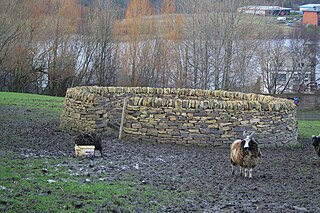 W
WA pen is an enclosure for holding livestock. It may also perhaps be used as a term for an enclosure for other animals such as pets that are unwanted inside the house. The term describes types of enclosures that may confine one or many animals. Construction and terminology vary depending on the region of the world, purpose, animal species to be confined, local materials used and tradition. Pen or penning as a verb refers to the act of confining animals in an enclosure.
 W
WA Persian well is a type of water well found in the Middle East, often used in conjunction with a qanat. These wells feature an ox-driven pump where the ox walks in circles around a central drive shaft which turns a wheel that raises water via a chain of buckets from the qanat or a well. In some cases water flows fast enough that a subterranean waterwheel may harness enough power to raise the buckets of water to the surface level.
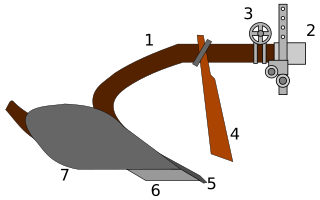 W
WIn agriculture, a plowshare (US) or ploughshare is a component of a plow. It is the cutting or leading edge of a moldboard which closely follows the coulter when plowing.
 W
WA screw picket is a metal device which is used to secure objects to the ground. Today, screw pickets are used widely to temporarily "picket" dogs. They are also used to graze animals such as sheep, goats, and horses. Screw pickets are also used to stabilize small trees, tent poles, and other objects that are intended to remain upright.
 W
WIn Russia, Finland, and a few nearby countries, a sokha is a light wooden ard, consisting of two body ards, with their parallel beams forming the two shafts for a single horse-drawn tillage implement with two socket shares (рассоха). In later types the double body is combined into one wooden board. Chronicles and other literary sources show that the sokha was in use in Russia at least since the 13th century. It originated from northern Russia, e.g., around Novgorod.
 W
WA sweat scraper is a tool used in horse grooming and with other animals, such as dogs. It consists of a handle and a rubber blade. Sweat scrapers are available in both metal and plastic form, and also traditionally in wood. It is used to remove sweat and/or excess hair from larger pets. It is used in much the same manner as a window cleaner would scrape water or foam from a window with a rubber blade. The typical use of a sweat scraper is now actually to remove excess water after washing a horse to help it cool down rather than for just sweat. Without the use of a sweat scraper, it would take more effort and additional rags to remove the same amount of excess water therefore the proper use of a sweat scraper helps to ensure an effective cool down process.
 W
WA yard is an area of land immediately adjacent to one or more buildings. It may be either enclosed or open. The word comes from the same linguistic root as the word garden and has many of the same meanings.
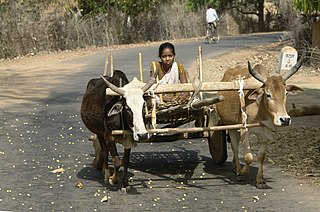 W
WA yoke is a wooden beam normally used between a pair of oxen or other animals to enable them to pull together on a load when working in pairs, as oxen usually do; some yokes are fitted to individual animals. There are several types of yoke, used in different cultures, and for different types of oxen. A pair of oxen may be called a yoke of oxen, and yoke is also a verb, as in "to yoke a pair of oxen". Other animals that may be yoked include horses, mules, donkeys, and water buffalo.